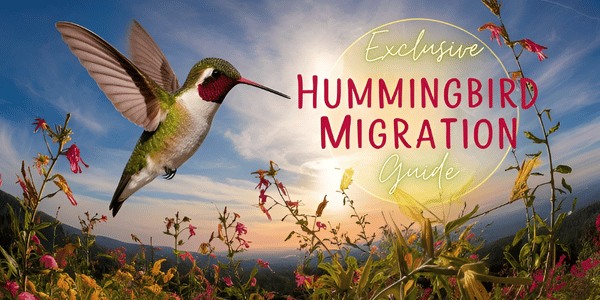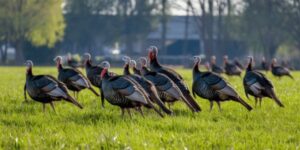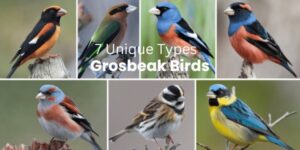Hummingbirds are one of nature’s most fascinating creatures. Their vibrant colors, rapid wing beats, and incredible agility make them a joy to watch. But did you know that many species of hummingbirds embark on long and arduous migrations every year?
Understanding hummingbird migration is intriguing and essential for their conservation. In this guide, we’ll dive deep into the world of hummingbird migration, exploring everything from why they migrate to how you can help them on their journey.
What Causes Hummingbird Migration?
A number of factors influence hummingbird migration, including genetic instincts, changing day lengths, weather patterns, and food availability, making it a complex process. While some, like the Ruby-throated Hummingbird, stay behind in warmer parts of the U.S., most North American hummingbirds fly southward towards Mexico and Central America during winter.
Here’s a closer look at the migration patterns of the most common U.S. species, excluding Anna’s Hummingbird, which tends to stay in its range year-round.
Ruby-Throated Hummingbird Migration
The Iconic Migrant
When one thinks about hummingbirds, the Ruby-Throated Hummingbird usually comes to mind first. It has the widest distribution across all states east of the Minnesota-Texas line.
Migration Timeline
It is possible to track their movement as it follows a certain pattern:
• March: Gulf Coast region arrival
• Early April: Expansion north until Tennessee
• Mid-May: Northernmost limits around Maine and Minnesota
On a local scale, however, times tend to be more specific; for example, Rhode Island County has them coming through on the third week of April, while Arkansas gets them by the third week of March.
Rufous Hummingbird Migration
A Cross-Continent Journey
Any hummer is an iconic trophy on any serious birder’s life list, but the Rufous Migration Route covers the longest distance. It has a wide wintering area in Mexico, while it breeds in Canada as it passes the western part of the USA.
Migration Route
• Late Winter/Spring: Migration up the West Coast
• May: Arrival in breeding areas like Washington, Oregon, Idaho, and Western Montana
• July/August: Southward migration begins through the Rocky Mountain states
This is a rather unique clockwise migration pattern, reflecting the resilience of these little creatures.
Calliope Hummingbird Migration
Small but Mighty
The Calliope Hummingbird, the smallest bird species found in North America, migrates along a similar route to Rufous Hummingbirds along the Pacific coast and down through the Rockies.
Migration Details
• Early Spring: Arrival at high elevations along the Pacific Coast
• Early May: Reach northwestern states, particularly mountainous regions
• Late Summer/Early Fall: Pass through the Four Corners states, typically leaving by late September
During its migration, this species prefers higher elevations and mountainous areas, which makes them harder to find but worth seeing if you do.
Black-Chinned Hummingbird Migration
Desert Dwellers
Black-chinned Hummingbirds’ winter habitat is Mexico’s Pacific Coast and Southern Texas, and their migratory path passes through the southwest U.S.A.
Migration Path
• Late February: Arizona arrival
• May: Spread as far north as Washington
• July-August: Begin leaving the northernmost parts of their range
• September: Stick around in southern areas like Arizona and New Mexico
These birds are generally lowland dwellers, especially within the Four Corners area.
Migration of Broad-Tailed Hummingbirds
High-Flying Migrants
Broad-tailed hummingbirds are another species that breed at high altitudes, extending from Mexico through the American Southwest.
Migration Journey
• Early March: Start heading north, preferring lower altitudes.
• March-April: Arizona, New Mexico, and Colorado
• Late May: Reaching Idaho
• August: Start the journey back south
During their southern migration, this species is most often seen in Utah, but the lengthiest viewing period is offered by New Mexico, which stretches from March to September.
You May Also Like: The Amazing Truth About Hummingbirds Sleeping Patterns
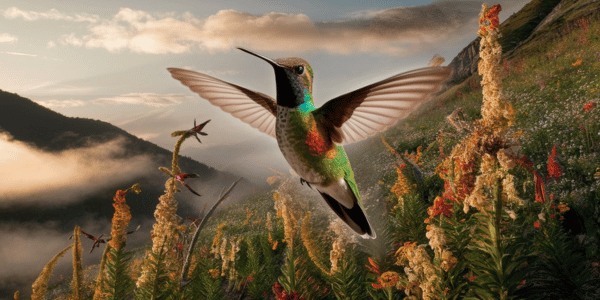
Why do Hummingbirds Migrate?
Their survival instincts make them migrate. This begins when food availability changes as the seasons change. During colder months, hummingbirds consume flower nectar, which is not frequently available. To ensure the birds have enough energy for this, they should move to places where they can find a lot of food.
Influence of Climate and Weather Patterns
Climate plays a significant role in migration because warmer climates enhance the growth of flowering plants that support hummingbird populations. Weather events such as cold fronts or strong winds also affect the timing and route taken during migration.
Food Availability and Energy Needs
Hummingbirds have very high metabolisms, so they need large quantities of food. During their migrations, they feed on nectar from flowers and insects to maintain their energy levels. Their constant need for nourishment is an important factor in their migratory behavior.
When do Hummingbirds Migrate?
Spring Migration; Timing and Patterns
The spring marks the beginning of a northward journey made by hummingbirds leaving Central and South America, where they hibernate during the winter season. The time these movements take place depends on when flowers bloom and different times when food supplies become available. In general, these birds start migrating any time after February until May passes.
Fall Migration; Preparation and Routes
By autumn, these tiny travelers are ready to fly south again to their overwintering areas. This usually begins in late July and ends in October. Hummingbirds use the same routes every year because they are well-established paths. This might be influenced by factors such as food, climate, or geographical landmarks.
Factors Influencing Migration Timing
Three things cause hummingbirds to decide when to migrate: increased daylight hours, a drop in temperature, and the availability of food. Additionally, some species also migrate early or late, depending on their breeding cycles.
You May Also Like: Hummingbird Dreams: Symbolism and Significance
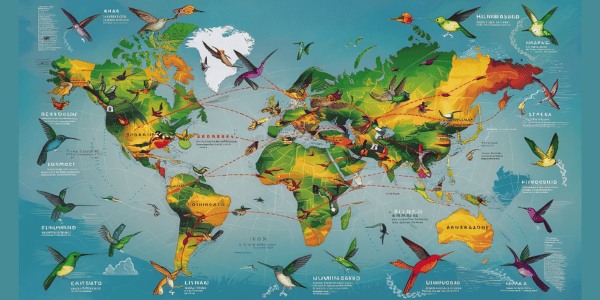
Key Migration Routes
Hummingbirds fly along specific migration paths known as flyways, which act as their liveliness and provide them with favorable habitats.
The Eastern Flyway
This is the route preferred by hummingbirds migrating from the eastern United States to Central America, where they use the Gulf Coast to get enough supplies for their journey.
The Central Flyway
Hummingbirds follow this central flyway as it crosses the United States heartland from the Great Plains down into Mexico. It offers different environmental conditions, hence attracting many species.
The Western Flyway
In North America, her western coasts host those species of hummingbirds that choose the Western Flyway for movement during summer. They come from the Northwest Pacific, through California, and into Mexico via many diverse landscapes.
Challenges Hummingbirds Face During Migration
These little creatures face so much hardship during their migration period.
Weather Hazards and Storms
After all, they may not be so safe against strong winds, heavy rains, and sudden temperature drops when migrating. These conditions will drain their energy reserves, making it difficult for them to continue their journey.
Predators Along the Route
Cats, hawks, and larger birds can attack them during migration. This may be due to the need for constant refueling, which makes Hummers easy prey.
Finding Food and Rest Stops
Migration is hard for hummingbirds since they find it difficult to get enough food on their way. Urbanization has reduced natural food sources, making it more challenging for these birds to get enough nectar to sustain them with energy.
You May Also Like: The Top 5 Yellow-Breasted Birds in Texas
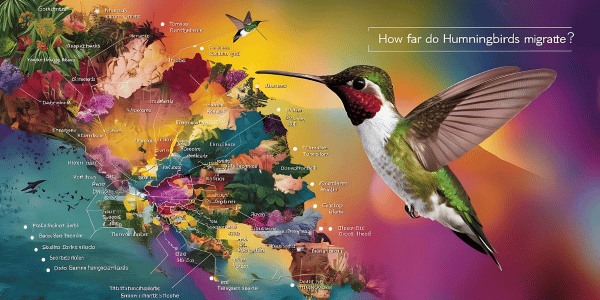
How Far Do Hummingbirds Migrate?
One of the things that makes hummingbirds unique is their ability to cover long distances over a short period of time during migration.
Short-Distance Migrants
Other species of hummingbird migrate only a few miles, moving from highlands to lowlands or northward towards the south.
Long-Distance Migrants
Like other species, the Ruby-Throated Hummingbird travels over 2,000 miles from Canada to Central America during its migration period.
Record-Breaking Journeys
The rufous hummingbird flies almost four thousand miles between Alaska and Mexico; this is one of the longest known bird migrations considering the size of this bird.
Preparing Your Garden for Hummingbird Migration
If you want your garden to attract migrating hummers, you can take various steps to create a hospitable environment for them.
Planting Native Flowers
Hummingbirds are best attracted by native plants because they give out nectar that these birds like and fit well into local weather conditions. It’s also good if you go for tubular flowers like bee balm, salvia, or trumpet vine, which attract their favorite bird, hummingbirds.
Setting Up Feeders: Tips and Tricks
Apart from planting flowers, you can also install hummingbird feeders to ensure a continuous food supply. Do not use red dye; instead, use a mixture of one part sugar and four parts water. The feeders must be cleaned regularly to discourage mold formation or bacteria growth.
Providing Water Sources
Birds need water for drinking and bathing. Consequently, it would be helpful if there was a shallow birdbath in your garden or even a misting system capable of keeping these birds hydrated and clean during migration.
You May Also Like: Symbolism and Spiritual Meaning of the Red Robin Bird

Best Times to Spot Migrating Hummingbirds
You may have an exciting experience spotting migrating hummers, but you need to understand their migratory patterns.
Spring and Fall: Peak Migration Times
The best months when migratory hummers can be seen are during spring and fall migrations. In springtime, watch them flying northwards, while in the autumn season, keep an eye on their southern travels.
Regional Differences in Hummingbird Sightings
Different hummingbirds may appear depending on where you are located, within different time frames. For example, such people residing in the east United States might see more Ruby-throated Hummingbirds, whereas those who live on the west coast will most likely notice Anna’s Hummingbirds.
How to Identify Migrating Hummingbirds
It can be difficult to identify hummingbirds because some species look so much alike. To help with identification, study their size, coloration, and behavior closely, or use a good birding app or field guide, which can also provide clues.
The Role of Conservation in Hummingbird Migration
Conservation efforts have a crucial role in ensuring that hummingbirds continue to migrate for generations.
Habitats and Flyways Protection
Hummingbird survival depends on the preservation of their natural habitats and flyways. This includes saving forests, wetlands, and other vital areas from development and degradation.
Impact of climate change
Changes in temperature and weather patterns can interfere with migration pattern timing and food source availability, thereby posing a major threat to hummingbird migration. Conservation should also consider the wider implications of climate change for these birds.
How You Can Help
There are numerous ways to help hummingbirds during migration. Some of the ways this could be achieved include planting indigenous flowers, setting up feeders, and participating in citizen science initiatives. Additionally, supporting groups involved in conserving habitats for these birds is another positive action we should take.
You May Also Like: The 21 Ugliest Birds: Nature’s Strange Creations

Amazing Facts About Hummingbird Migration
The story behind hummingbird migration is full of unbelievable facts, which prove how adaptable they are, considering their small size.
Incredible Speeds And Endurance
Despite being small, these tiny birds are able to fly at speeds of up to 30 miles per hour or more without stopping for long distances. Their wings flap so fast that they can hover while feeding specific flowers accurately.
Unique Navigation Abilities
Their exceptional sense of direction enables them to navigate thousands of miles during migrations. They are believed to use the Earth’s magnetic field, among other landmarks, such as the position of the sun, for navigation purposes.
The Science Behind Their Journey
Scientists still wonder how Hummers store enough energy before embarking on very long migrations. It is thought that they may go into torpor, a state similar to hibernation, so as not to spend too much energy when flying long distances.
Common Myths about Hummingbird Migration
There are many misconceptions about hummingbird migration.
“Not All Hummingbirds Migrate, Right?”
Not all types of hummingbirds migrate. For example, some species, like Anna’s Hummingbird, stay year-round in their breeding grounds, especially if the climate is mild.
“Can Hummingbirds Fly Without Stopping?”
Though they are known for their ability to fly even a thousand miles without stopping, they cannot fly this distance without halting at intervals. They usually rest and refuel during these breaks while on the move.
“Do Hummingbirds Migrate Alone?”
Amongst other birds, hummers are not gregarious migrators; rather, they carry out solitary migrations one by one, following different routes and timing.
Concluding about Hummingbird Migration Guide
Hummingbird migration is among the most incredible phenomena observed in the natural world. These tiny birds traverse very long distances and face various obstacles on their way. By understanding their migration patterns and taking measures to support them, we could help ensure that generations unborn will still be able to appreciate their beauty and resilience. Whether you are a keen ornithologist or just someone who enjoys seeing a hummingbird flutter past once in a while, there is something magical about watching these extraordinary creatures travel during their migratory journeys.
FAQs about Hummingbird Migration Guide
What is the Longest Migration Recorded for a Hummingbird?
The longest route ever recorded for any hummingbird is the Rufous Hummingbird, which flies around 4000 miles from Alaska all the way south into Mexico.
Do All Species of Hummingbirds Migrate?
No, not all species of hummingbirds migrate. Some species, such as Anna’s Hummingbird, remain in the same place throughout the year, especially during mild weather conditions.
How Do Scientists Study Hummingbird Migration?
There are many ways scientists study hummingbird migrations, including banding, tracking with GPS devices, and citizen science projects.
Can Hummingbirds Fly at Night?
Yes, they can fly at night, as they do during daytime hours. However, predators cannot see them easily during nighttime hours because it is cooler then.
What Should I Do if I See a Hummingbird Out of Season?
If you spot an out-of-season hummingbird, ensure that it has food and water. If there seems to be no problem with its health condition, it might just be an early or late migrant. Weak or injured hummingbirds should immediately notify a wildlife rehabilitator within your area if spotted.
How Can I Help Hummingbirds during Migration?
Some of the things you can do include planting flowers indigenous to your region, putting up feeders, or providing water sources within your garden. Moreover, supporting conservation activities and participating in citizen science projects have a major effect on these animals.
What Should I Do if I Find an Injured Hummingbird?
If you encounter an injured hummingbird, it is best to contact a local wildlife rehabilitator or organization that specializes in bird rescue. They can provide the necessary attention and care for the bird.
Is it Safe to Leave My Feeder up during winter?
In areas where winters are not too cold, it might be possible to leave your feeder up all year. Still, otherwise, it’s advisable to remove it once hummingbirds have migrated so that they won’t be tempted to stay longer than necessary.

